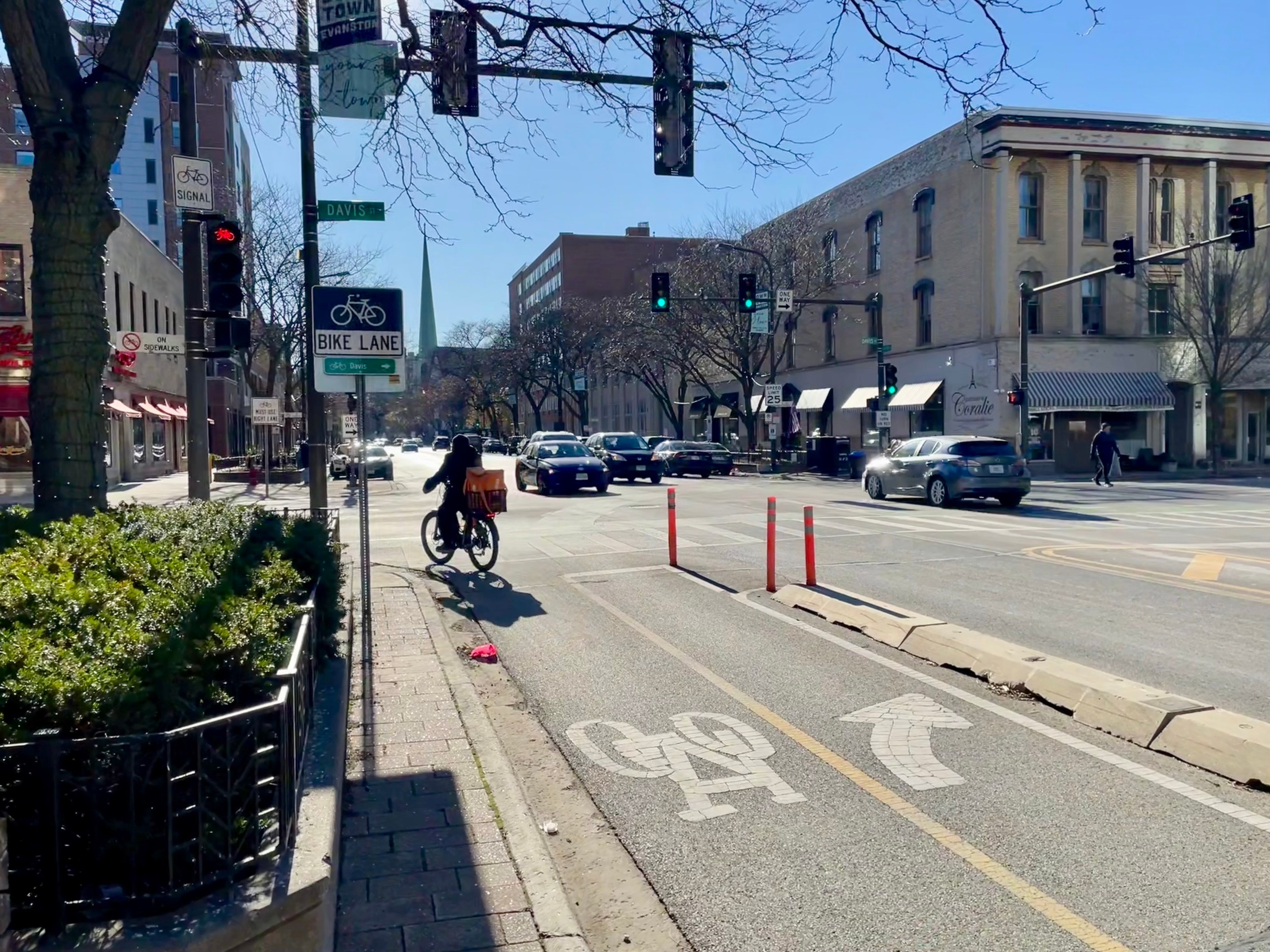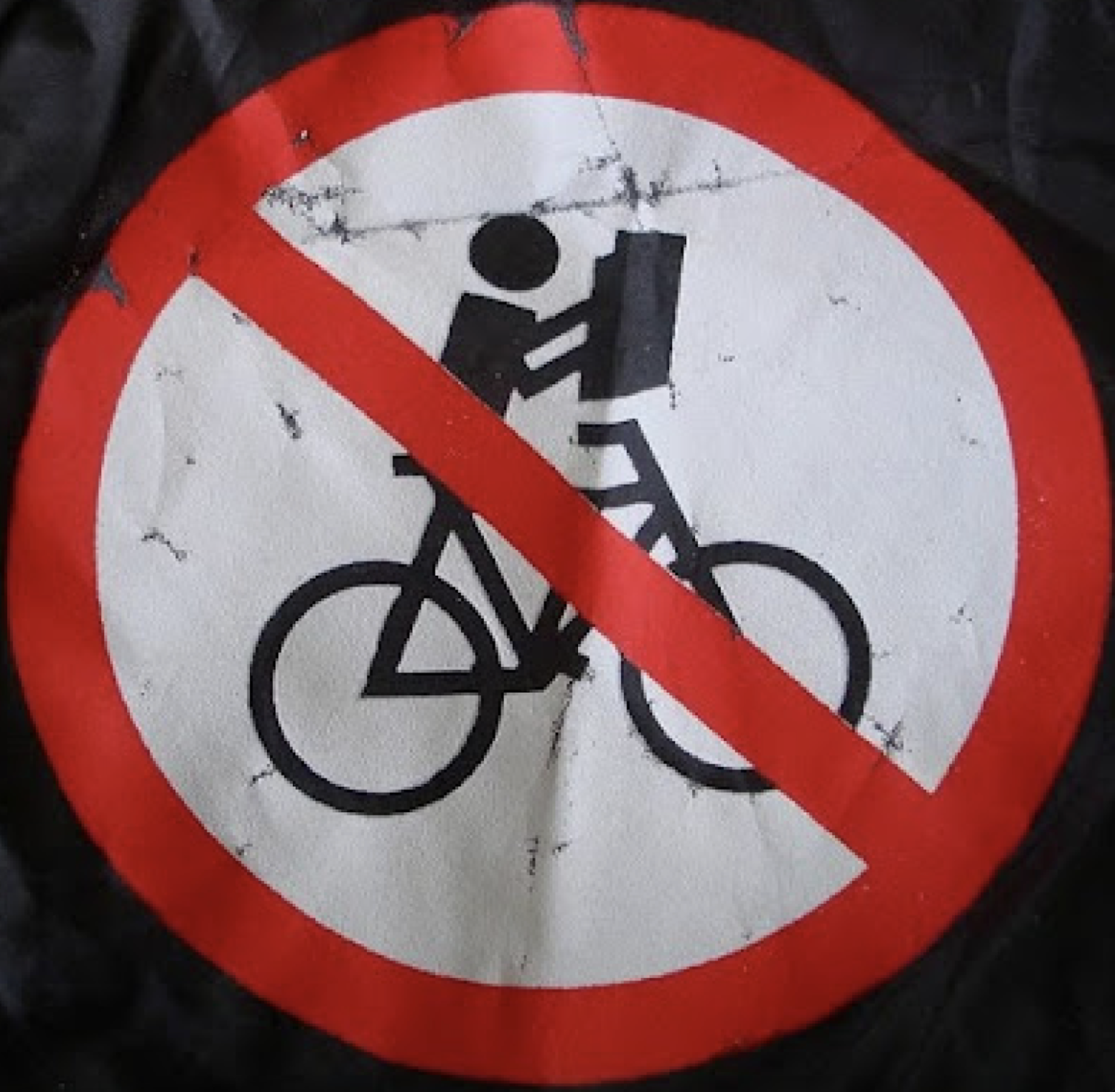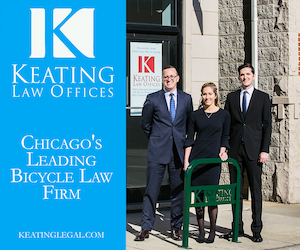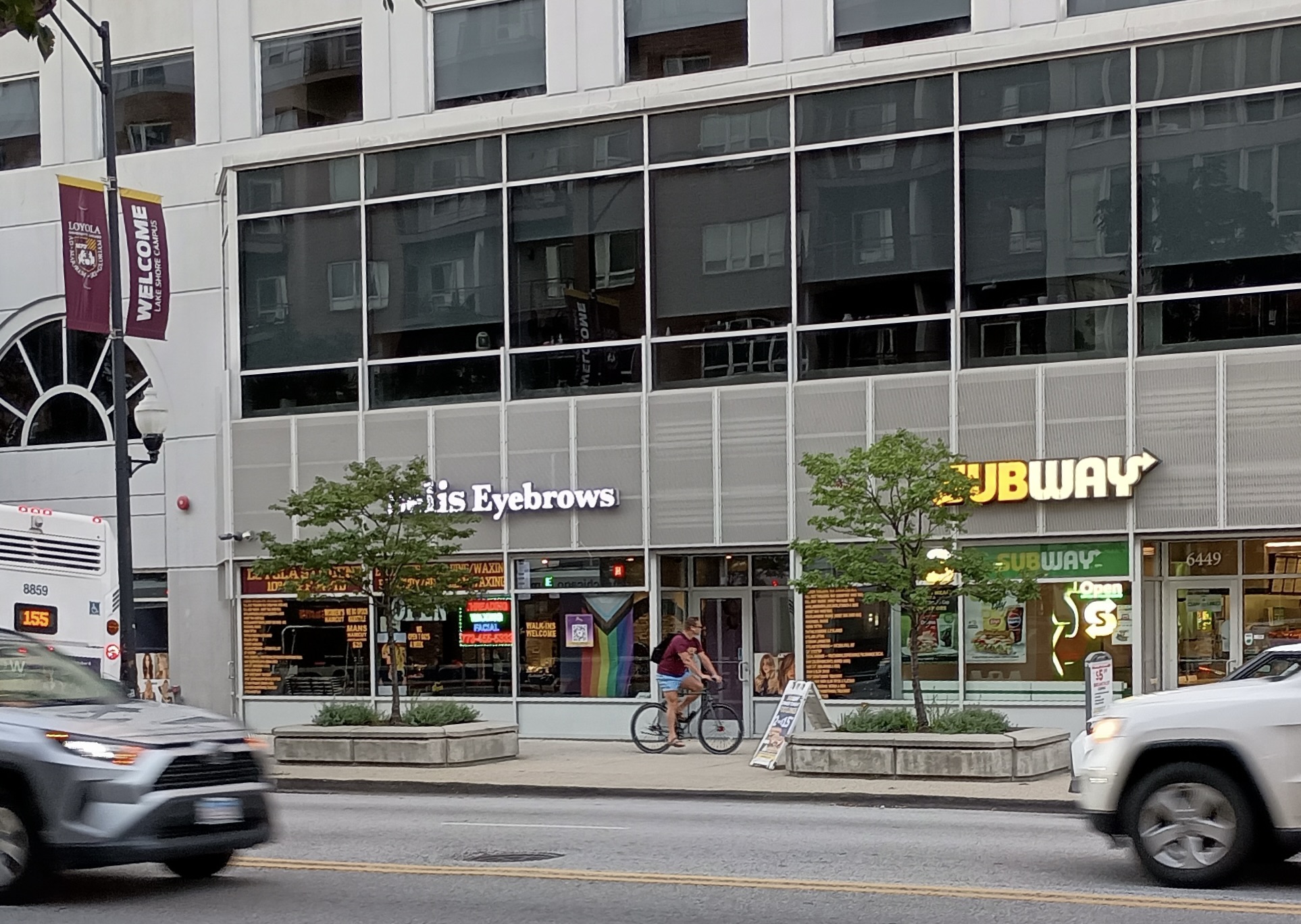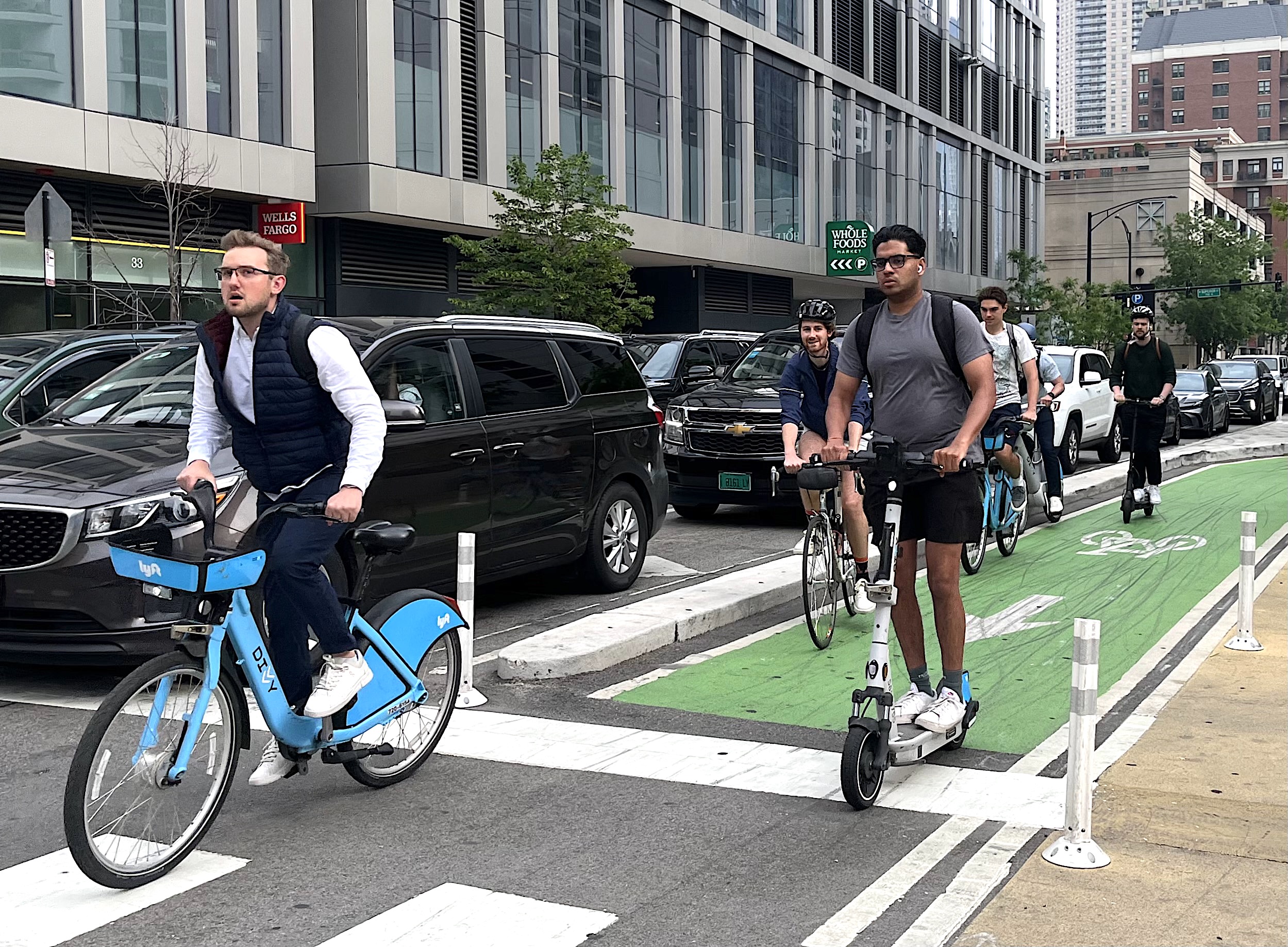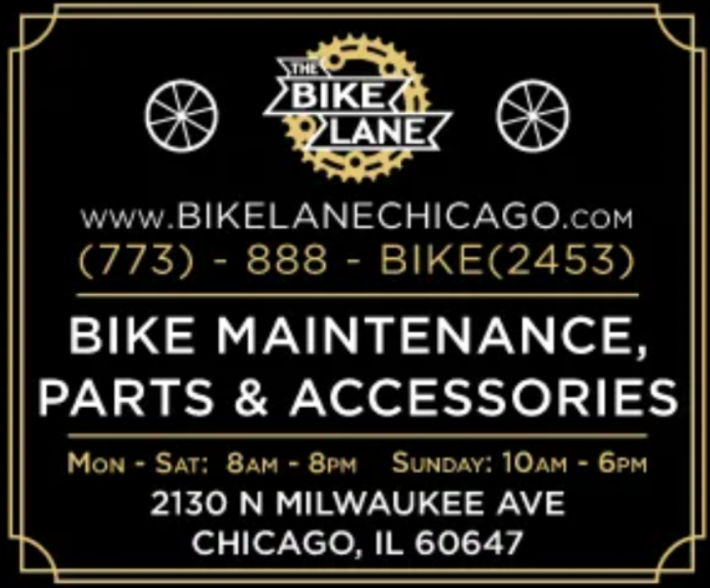
With apologies to Mark Twain, reports of the death of Evanston's Chicago Avenue two-way protected bike lane extension have been greatly exaggerated.
(If you're unfamiliar with the City's previous design proposal, you can read our most recent coverage here, or check out the project webpage here.)
On November 25, Evanston Now ran the headline, "Merchants say 'no' to protected bike lanes." The report was based on two different letters sent by a total of 62 business people and "avid cyclists" opposed to plans to convert parking spaces to make room for extending the existing bikeway south from Davis Street to the city of Chicago border.
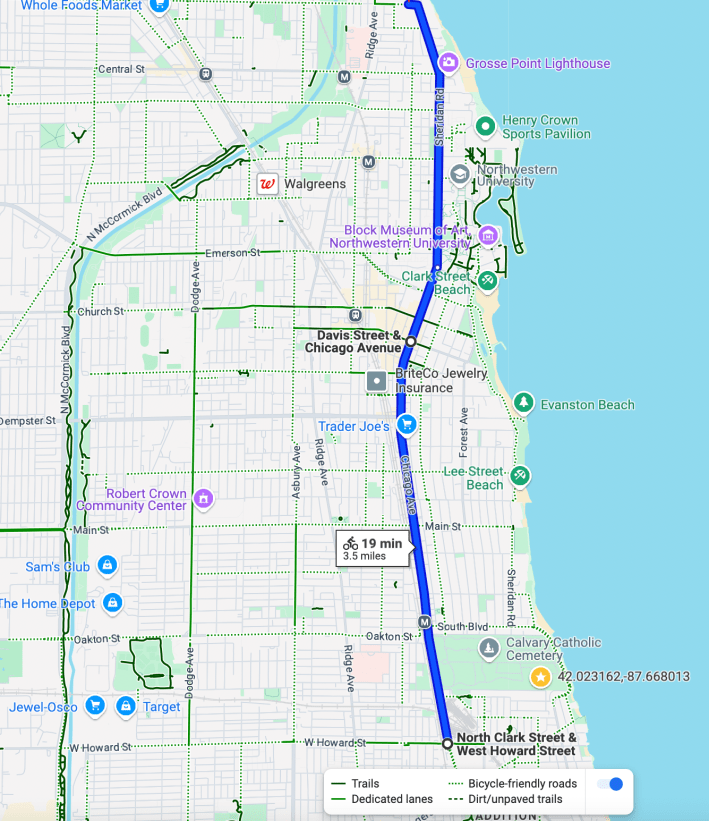
Not to be outdone, on December 1, Evanston RoundTable added fuel to the fire with the title, "Opposition mounting for proposed Chicago Ave. bike lane." But we should probably dock them some points because they quoted a developer claiming the project would "wipe out 75 to 100 parking spaces," then had to run a correction because the City's proposed number at the time was only 66 spots.
But a few things have happened since then to brighten the PBL's future. The advocacy group Evanston Transit Alliance collected 281 signatures for a letter of support for the protected lanes cheerleading the initiative. Impressively, some of the same merchants who signed the previous message opposing the project changed their position after getting more facts about the proposal.
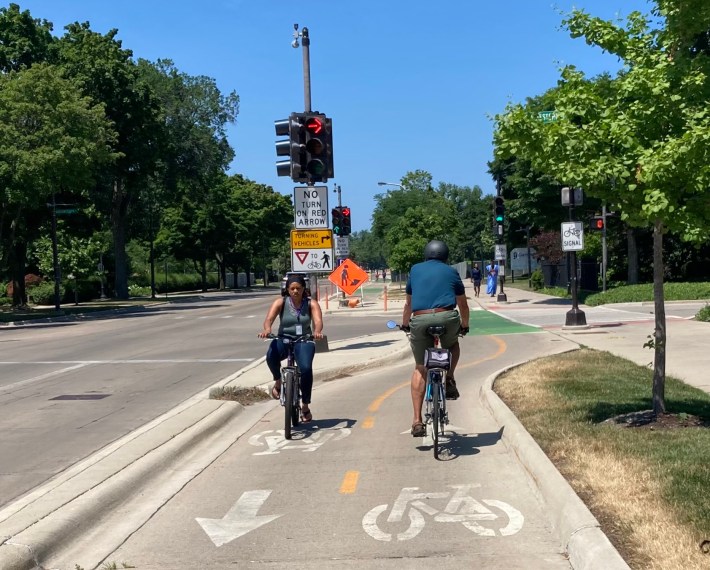
On December 9, the community group Southeast Evanston Association voiced support for installing the PBLs on Chicago Avenue on its website. "The bike lane's primary purpose is to serve Northwestern University students cycling to and from campus," it stated, rejecting alternative proposals to relocate the cycling route to side streets. "To divert them away from the most direct route would appear to decrease their access to local businesses. At the same time, they are more likely to remain on Chicago Avenue, where they would not be protected and thus face increased safety hazards."
Also on December 9, Evanston Now acknowledged which way the wind was blowing with the headline, "Residents, business owners back protected bike lanes." Maybe the opposition wasn't mounting after all?
That said, there were plenty of Not In My Backyard and Not In Front of My Storefront types at Tuesday's community meeting on the proposal, held at the Robert Crown Community Center, 1801 Main St. There was a standing-room-only crowd of over 125 attendees, also including many passionate sustainable transportation advocates, many of whom biked there.
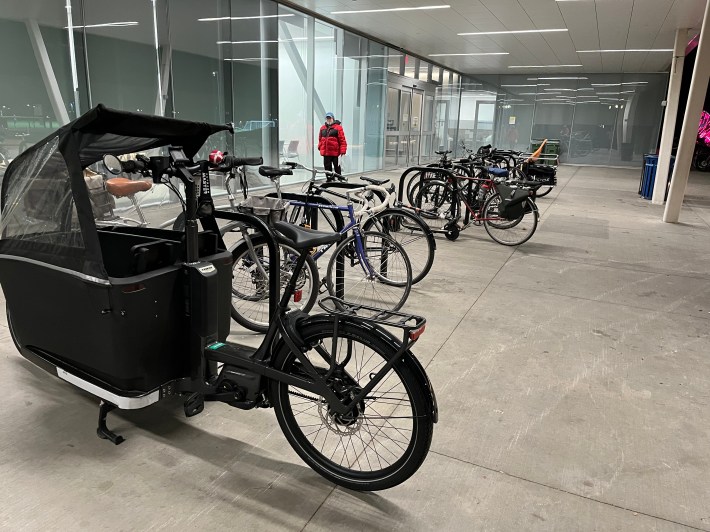
My impression was that all but the most incorrigible motorheads felt more positively about the bikeway proposal by the end of the evening. City officials revealed that, in response to pushback from the windshield crowd, the designers came up with a new PBL layout that would not only save all of the current 248 car spots, but it would actually add two new ones.
That opinion shift is a good thing, but there are some downsides to the new parking preservation proposal. For starters, it's worth noting that converting car spaces for protected bike lanes can actually help businesses' bottom line. As Streetsblog previously noted, such has been the case in cities like New York City and Seattle.
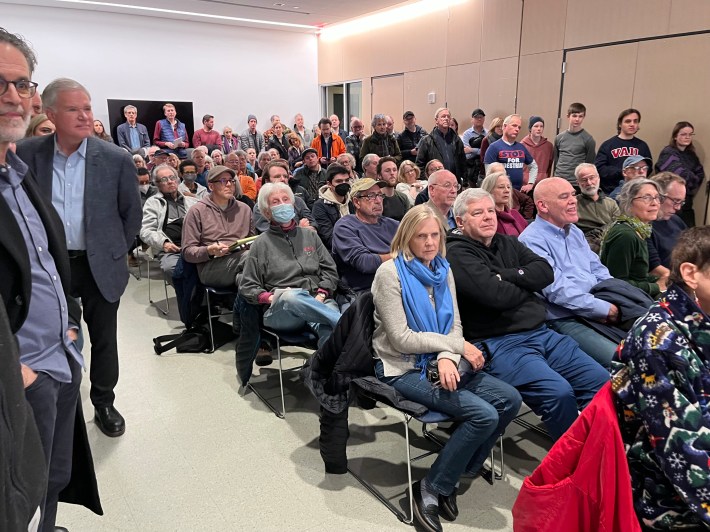
Moreover, in addition to the protected lanes, another reason why car spots would be converted is to make room for wider sidewalks for the retail corridor, which would also increase foot traffic and boost sales. So continuing to reserve that public right-of-way for storing large, privately owned metal boxes would mean sacrificing space for human beings on foot.
The designers were also able to gain some car spots by shrinking the space between parked vehicles and driveway openings. While officials at the meeting said this layout would still comply with federal safety regulations, this practice doesn't sound ideal in terms of drivers' sight lines.
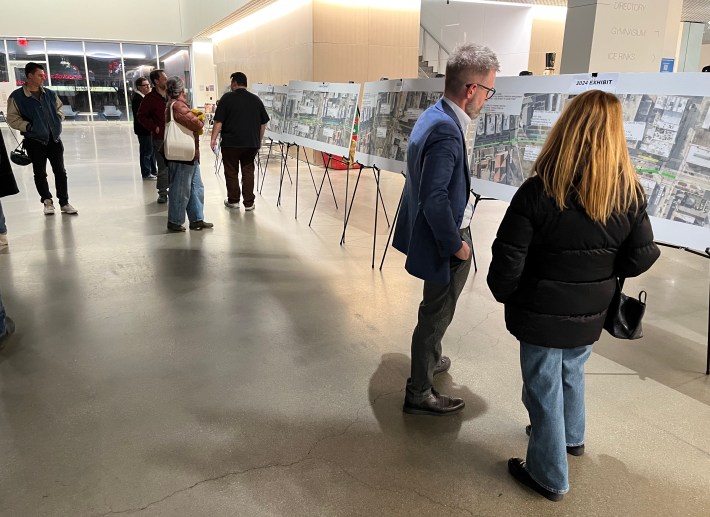
Evanston's 3rd Ward Councilmember Melissa Wynne, whose district includes most of the affected businesses, kicked off Tuesday's discussion, "There's been a lot of misinformation about the bike lanes and the Chicago corridor plan that's been floating out there," she said. "And tonight what we're trying to do is provide accurate information for folks, hear what your comments and questions are about this, and incorporate those to the extent that that's possible."
Wynne noted that the original design that would widen sidewalks and maintain driveway layouts, dubbed Plan A, and the new scenario where parking would be increased, called Plan B, are both still under consideration. "That number that is going from 248 to 250 is tentative tonight," she concluded. "So don't think that we're writing this in stone. It may change depending on suggestions and comments that we hear from this group tonight, and from the community going forward. But that's tentatively where we stand at this point."
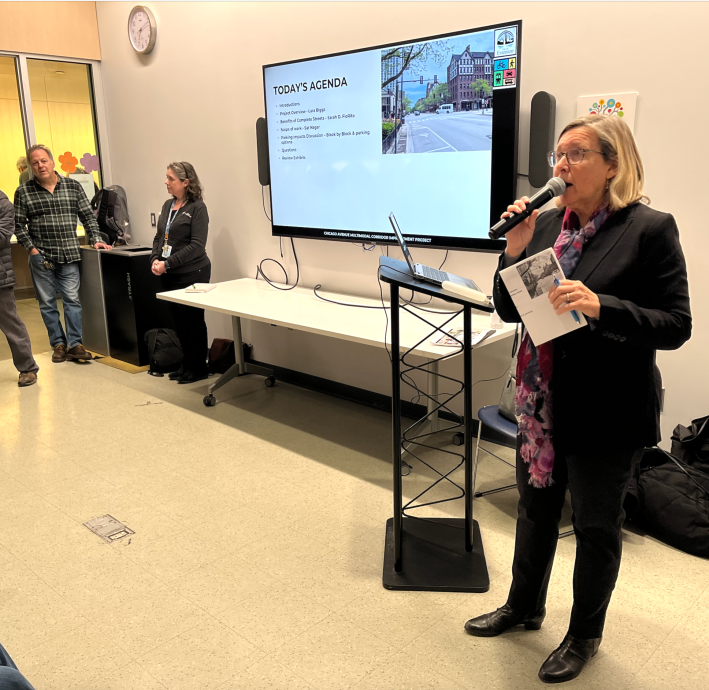
"I want to emphasize that this is more than just a bike lane," added Councilmember Jonathan Nieuwsma of the neighboring 4th Ward. "This is a multimodal plan to make Evanston safer, regardless of your transportation... One of the messages that I've been hearing from constituents with increasing frequency is concern for their safety when people are walking and biking through the 4th Ward."
Evanston City Engineer Lara Biggs noted that the project will also include sidewalk improvements and ADA upgrades, new LED lighting, re-timing stoplights with the goal of improving traffic flow, sidewalks. "We really need to do some major improvement on Chicago Avenue," she said. "Bike lane aside, it's aged. It definitely needs that TLC."
Biggs added that the "community-led" planning process has included two public meetings, and 18 stakeholder group meetings. "If we said 'What would you like to see for bike accommodations?' we heard 'Two-way protected bike lanes.'"
The Illinois Department of Transportation has given the project Phase I design report approval, a must for lining up funding, Biggs said. She added that with its safety and sustainable transportation focus it's "a very eligible project for different federal funding programs." The downside of having IDOT and the feds involved is a long planning timeline, including periods without public outreach. "That is just an unfortunate evil of doing really big projects."
But Biggs promised the wait would be worth it. "Where we have installed protected bike lanes... such as on Chicago Avenue north of Davis, we do see significant improvements in [crashes], particularly ones involving pedestrians," she said.
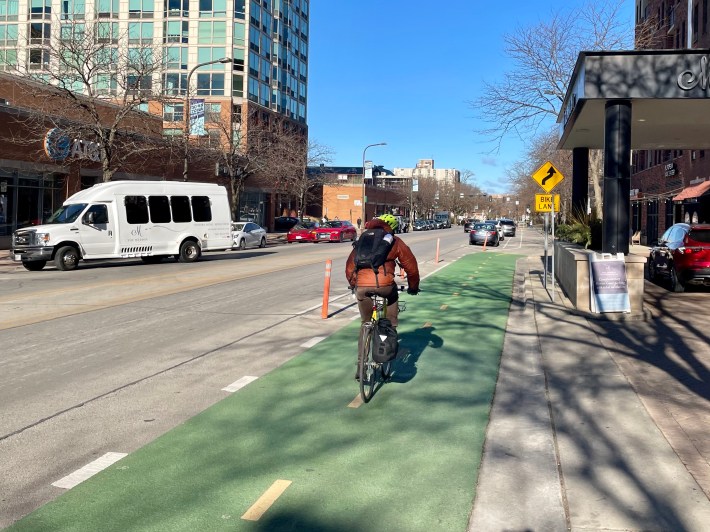
Evanston's Transportation and Mobility Coordinator Sarah FioRito addressed the concerns about parking. "All of our business districts do have a finite capacity to store private cars," she said. "And one thing that Complete Streets can offer is for folks who do not want to bring their cars into the business district to actually travel to and through the business district." She noted that big changes to New York City's 9th Avenue and San Francisco's Valencia Street resulted in a "very significant sales increase."
FioRito added that investments in safe cycling facilities lead to more ridership. "The idea of creating these networks and making them more robust, yes, is to definitely serve those who are already relying on these streets to be safe and to make them safer. [But] also it's to support more folks having the option to choose these modes and feel like they are a viable, comfortable mode for them."
Evanston Senior Engineer Sat Nagar, the project manager, said he believes, "Evanston will be the first city in the whole U.S. which will have a multi-modal corridor from one end to the other end." The crowd applauded.
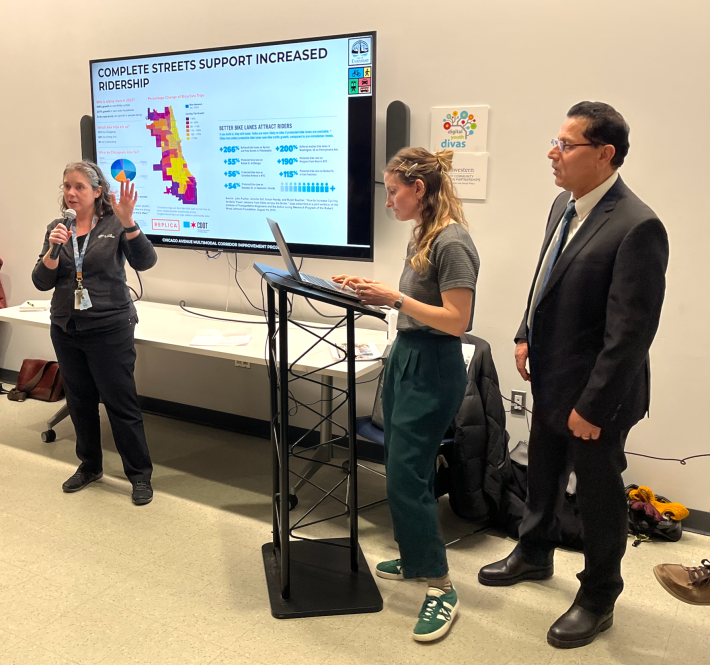
That's not to say that the Q & A part of the meeting was a love fest. There were complaints from some business owners and residents who claimed they weren't informed about the previous community meetings. Biggs replied that the City sent postcards and put fliers on each door in the corridor.
While Plan B would increase the number of parking spaces, other attendees weren't happy about the relocation of the car spots. Some merchants were upset that the new design would not offer them or their customers the type of "rock star" parking in front of storefronts to which they are accustomed, as if not having to walk a block or so to a destination is a human right.
Cesar Marron, owner of Sketchbook Brewery, 821 N. Chicago Avenue wasn't one of the disgruntled business owners. "We usually have 80 to 100 people at our business, so they must be the problem because they're parking in your parking spots," he joked. "There are only four parking spots in front of our business and we can still hold more than 80 people. Yeah, they're walkin' there, so I don't think that's a problem at all. If I had it my way, I would close Chicago Avenue to traffic completely." Audience members applauded. Obviously, if no one ever drove home from a night of drinking, the world would be a better place.
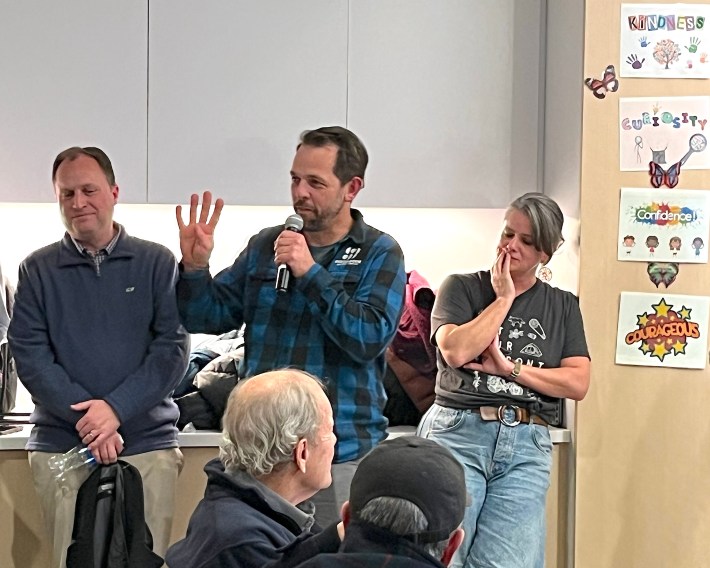
The most prominent naysayer in the audience was Laura Kushner, who said she owns a townhome in the Courts of Evanston complex on the 500 block of Chicago Avenue, just north of Calvary Cemetery. Kushner is opposed to the current PBL proposal, including the new Plan B version, because it still would convert all the car spots on her block.
Now, obviously occupants of the graveyard have no need for on-street parking. But arguably neither do Courts of Evanston homeowners, since Kushner acknowledged they all either have one- or two-car garages. But she implied there was simply no way for her to accommodate visitors or contractors without additional curbside parking directly in front of her building.
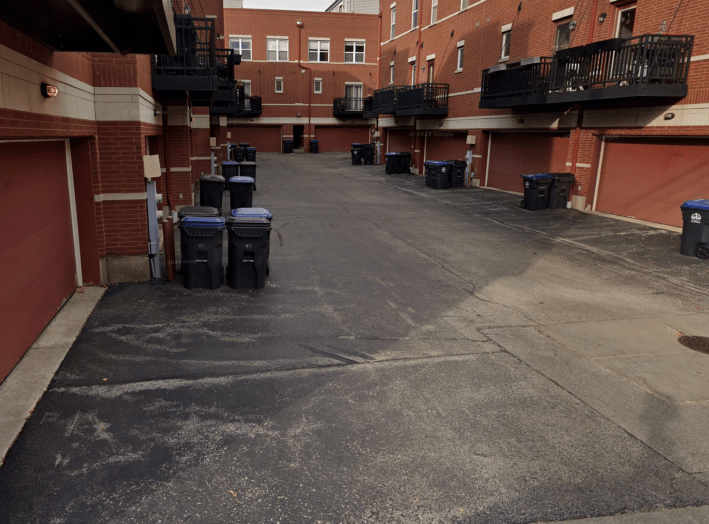
The Evanston RoundTable's December 1 article gave Kushner eight paragraphs to voice various grievances about the project and the process.
Similarly, Kushner spent a full five minutes of the Q & A session monologuing at the audience with her back to the City staffers. At one point, another attendee cheekily asked her, "Do you have a question?"
Update 12/13/24, 8:30 AM: The RoundTable once again gave Kushner lots of attention its writeup of Tuesday's meeting. Kushner got roughly twice as much digital ink in that article as five different PBL supporters, total, while the reporter failed to mention that Kushner owns at least one garage space.
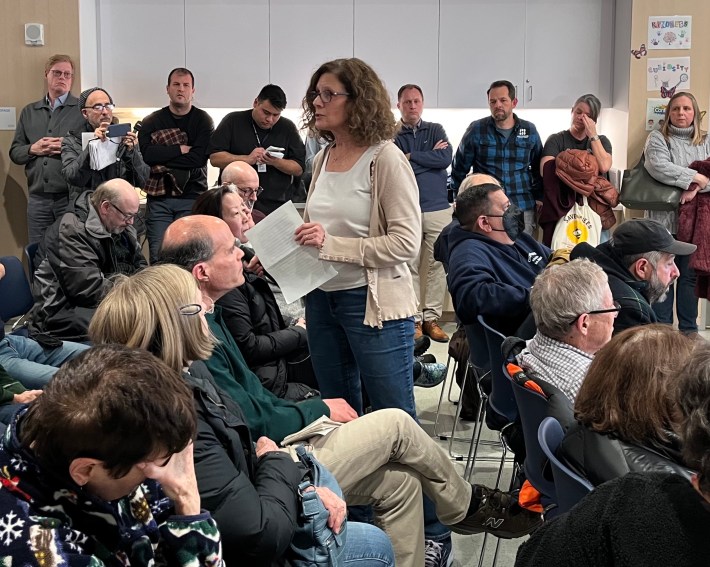
One of Kushner's seemingly valid complaints was that Wynne told her months ago she would ask the City's parking department to do a walk-through with the homeowner to help locate more on-street parking, but that never happened. The Councilmember responded that the two of them could schedule a walk-thorough immediately after the meeting.
Wynne added that she previously proposed designating the parking on Keeney Street and South Boulevard, the cross streets near Courts of Evanston, as resident-only, "I got a huge hue and cry from neighbors who said they did not want that, so I had that proposal tabled."

Wynne also debunked Kushner's claim that an upcoming 60-unit affordable development near her townhome would exacerbate the supposed curbside parking crunch. "We know that the average of permits that are used in that lot is 20," the politician said. "Those 20 spaces will be accommodated in the design of the new affordable housing project. There will also be some parking for residents there. The studies indicate that folks who move into affordable housing units do not always have cars."
Sarah Hanson, another nearby resident, offered a marked contrast to Kushner's perspective. "Most of us could walk to get to a business," she said. "I have been riding my bike in Evanston since I was 30, now I'm 62, still riding it around. Everybody, we have a global climate crisis. And one of the ways to try to help with that is to try to reduce our reliance on fossil fuels... And so, if we can all try to move in the direction of bikes and walking, that would be a great thing."
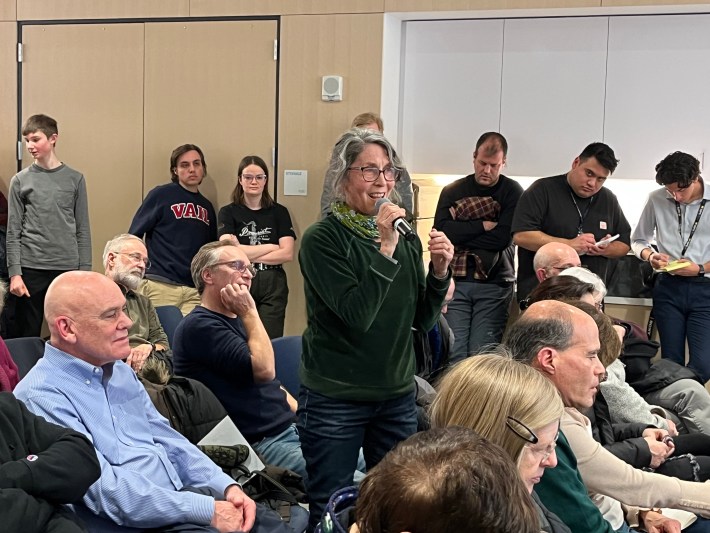
Local high school sophomore Olin Wilson-Thomas, who said he bikes to classes every day, offered a similar POV. He recently visited businesses that initially signed the letter against Plan A, thinking it would convert all their parking spots. "When I explained it would only take away 66 parking spaces, they said, 'Wow, that's not so bad,'" he reported. Some of them actually wound up signing the Evanston Transit Alliance petition in favor of the project. "If they had heard about plan B, I'm sure that they would be onboard."
Likewise, a City staffer I spoke with after the meeting said they were optimistic that the protected bike lane will ultimately be approved. However, they indicated that Plan B, preserving all the existing car spots and adding two more, is the most likely outcome. "Unfortunately, you can't do all three: wider sidewalks, protected bike lanes, and parking."
Sure, it would be preferable if the City stuck with Plan A, which would make walking safer and more pleasant, while benefitting local businesses by providing additional room for sidewalk cafes. But as they say in Evanston, half a loaf from Bennison's Bakery is better than none.

Did you appreciate this post? Streetsblog Chicago is currently fundraising to help cover our 2025-26 budget. If you appreciate our reporting and advocacy on local sustainable transportation issues, please consider making a tax-deductible donation here. Thank you!
